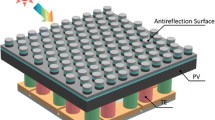Abstract
The infrared radiative properties of one heavily doped silicon complex grating and its corresponding four modified complex gratings with attached features at transverse magnetic wave incidence were numerically investigated by employing the finite-difference time-domain method. For the complex grating, by properly choosing the carrier concentration and geometry, it exhibited a broadband absorptance peak at wavelengths between 7 and 12 μm resulting from the excitation of surface plasmon polaritons. As for the four modified complex gratings, though absorptance spectra of the gratings almost remained unchanged, their locations shifted towards longer wavelengths. Meanwhile, the spectral absorptance peaks of two modified complex gratings were wider than that of the grating without attached features. Such broadened peaks could be partly attributed to the cavity resonance within the grating structures demonstrated by the electromagnetic fields and Poynting vectors plots. Finally, through comparing the spectral absorptances of complex gratings with two symmetrical square features in three sizes, it was shown that the peak wavelength shifted toward longer wavelengths with enlarged feature size. This work theoretically laid a foundation for the optimized design and application of the infrared detector with high performance.
Similar content being viewed by others

References
Zhang Z M. Nano/Microscale Heat Transfer. New York: McGraw-Hill, 2007. 32–47
Hesketh P J, Zemel J N, Gebhart B. Organ pipe radiant modes of periodic micromachined silicon surfaces. Nature, 1986, 324: 549–551
Hesketh P J, Zemel J N, Gebhart B. Polarized spectral emittance from periodic micromachined surfaces. I. Doped silicon: The normal direction. Phys Rev B, 1988, 37: 10795–10802
Gall J L, Oliver M, Greffet J J. Experimental and theoretical study of reflection and coherent thermal emission by a SiC grating supporting a surface-phonon polariton. Phys Rev B, 1997, 55: 10105–10114
Greffet J J, Carminati R, Joulain K, et al. Coherent emission of light by thermal sources. Nature, 2002, 416: 61–64
Chen Y B, Zhang Z M. Heavily doped silicon complex gratings as wavelength-selectvie absorbing surfaces. J Phys D-Appl Phys, 2008, 41: 1–8
Tan W C, Sambles J R, Preist T W. Resonant tunneling of light through thin metal films via strongly localized surface plasmons. Phys Rev B, 2000, 61: 13177–13182
Hibbins A P, Sambles J R, Lawrence C R. Excitation of remarkably nondispersive surface plasmons on a nondiffracting dual-pitch metal grating. Appl Phys Lett, 2002, 80: 2410–2412
Laroche M, Marquier F, Carminati R, et al. Tailoring silicon radiative properties. Opt Commun, 2005, 250: 316–320
Chen Y B, Chen J S, Hsu P f. Impacts of geometric modifications on infrared optical responses of metallic slit arrays. Opt Express, 2009, 17(12): 9789–9803
Marquier F, Joulain K, Mulet J P, et al. Engineering infrared emission properties of silicon in the near field and the far field. Opt Commun, 2004, 237: 379–388
Basu S, Lee B J, Zhang Z M. Infrared radiative properties of heavily doped silicon at room temperature. J Heat Transfer, 2010, 132: 203301–203308
Taflove A, Hagness S C. Computational Electrodynamics: The Finite-Difference Time-Domain Method. 3rd ed. Boston: Artech House, 2005. 85–116
Fu K, Hsu P F. Modeling the radiative properties of microscale random roughness surface. J Heat Transfer, 2007, 129: 71–78
Yee K S. Numerical solution of initial boundary value problems involving Maxwell’s equations in isotropic media. IEEE T Antennas Propag, 1966, 14(3): 302–307
Bohren C F, Huffman D R. Absorption and Scattering of Light by Small Particles. New York: John Wiley & Sons, 1983. 56–89
Kunz K S, Luebbers R J. The Finite Difference Time Domain Method for Electromagnetics. Boca Raton: CRC Press, 1993. 127–153
Fu K, Hsu P F. Radiative properties of gold surface with one-dimensional microscale Gaussian random roughness. Int J Thermophys, 2007, 28: 598–615
Hessel A, Oliner A A. A new theory of the Wood’s anomalies on optical gratings. Appl Opt, 1965, 4: 1275–1297
Author information
Authors and Affiliations
Corresponding author
Rights and permissions
About this article
Cite this article
Wang, A., Hsu, P., Chen, Y. et al. Effects of nanoscale features on infrared radiative properties of heavily doped silicon complex gratings. Sci. China Technol. Sci. 53, 2207–2214 (2010). https://doi.org/10.1007/s11431-009-3191-5
Received:
Accepted:
Published:
Issue Date:
DOI: https://doi.org/10.1007/s11431-009-3191-5



